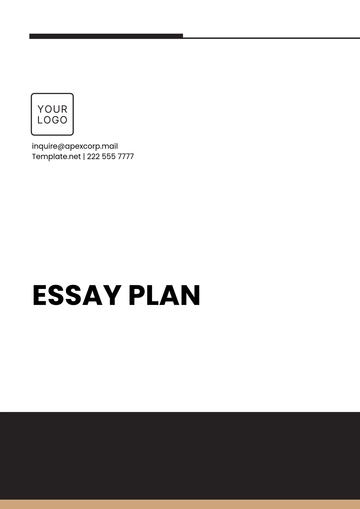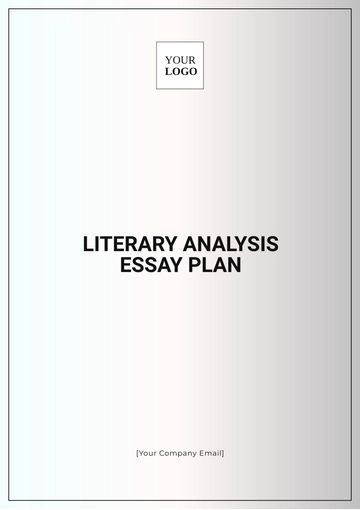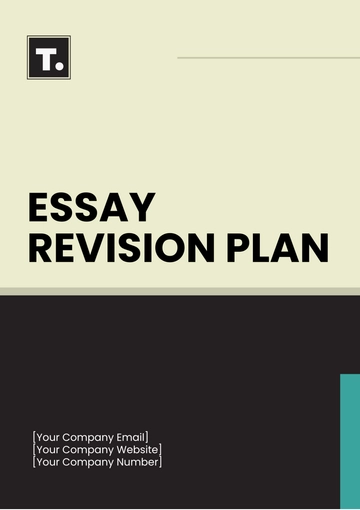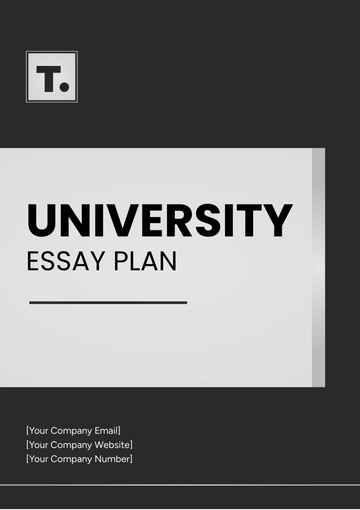Free Poetry Essay Plan

Written by: [YOUR NAME]
I. Introduction
Objective: This template aids in structuring a detailed analytical essay on poetry, emphasizing interpretation, thematic exploration, and the poet's linguistic craftsmanship.
Purpose: Introduce the specific poem and poet being analyzed, and outline the primary themes or interpretive questions your essay will explore.
Thesis Statement: [THESIS STATEMENT] - Clearly state your central argument or interpretation of the poem that you will support throughout your essay.
II. Poem Overview
Poem Title: [TITLE OF THE POEM]
Poet's Name: [POET'S NAME]
Publication Date: July 1, 2050
Context: Summarize the relevant historical, cultural, or personal background information that informs the poem.
Aspect | Description |
|---|---|
Historical | [HISTORICAL CONTEXT] |
Cultural | [CULTURAL CONTEXT] |
Personal | [POET'S BACKGROUND] |
III. Thematic Analysis
Primary Theme: Outline the main theme of the poem.
Evidence: Cite specific lines or stanzas that illustrate this theme.
Secondary Themes: Discuss additional themes that complement or contrast with the main theme.
Evidence: Provide textual evidence to support these themes.
Theme | Evidence (lines or stanzas) | Significance |
|---|---|---|
Primary Theme | [PRIMARY THEME EVIDENCE] | [SIGNIFICANCE OF THEME] |
Secondary Theme(s) | [SECONDARY THEME(S) EVIDENCE] | [SIGNIFICANCE OF THEME] |
IV. Literary Devices
Figurative Language: Analyze the poet’s use of simile, metaphor, imagery, etc.
Examples and Impact: Describe specific instances and their effect on the poem's meaning and tone.
Sound Devices: Examine elements such as rhyme, rhythm, alliteration, and assonance.
Examples and Effectiveness: Show how these devices enhance the poem's impact or themes.
Device Type | Example from Poem | Impact on Poem |
|---|---|---|
Figurative Language | [EXAMPLE OF FIGURATIVE LANGUAGE] | [IMPACT OF DEVICE] |
Sound Devices | [EXAMPLE OF SOUND DEVICE] | [IMPACT OF DEVICE] |
V. Structure and Form
Form Analysis: Detail the poem's structure (e.g., sonnet, free verse, haiku) and discuss its influence on interpretation.
Form Details: [SPECIFIC STRUCTURAL ELEMENTS OF THE POEM]
Line-by-Line Analysis: Conduct a close reading of key sections, discussing how form and content interact.
Key Sections to Analyze: [IMPORTANT LINES OR PASSAGES]
VI. Comparative Analysis
Comparison with Other Works: If applicable, compare the poem with other works by the same poet or contemporary works in the same genre.
Comparative Points: [POEMS OR POETS FOR COMPARISON]
Similarities and Differences: Discuss thematic and stylistic elements of the poem being analyzed.
VII. Conclusion
Summary of Analysis: Recap the insights and how they support your thesis statement.
Implications of the Findings: Reflect on what your analysis reveals about the poem, the poet's broader work, or the literary period.
Concluding Thoughts: Offer a final thought that encourages further reflection or study.
Final Statement: [FINAL CONCLUDING REMARK]
- 100% Customizable, free editor
- Access 1 Million+ Templates, photo’s & graphics
- Download or share as a template
- Click and replace photos, graphics, text, backgrounds
- Resize, crop, AI write & more
- Access advanced editor
Introducing the Poetry Essay Plan Template from Template.net! Crafted for versatility, this editable and customizable tool empowers writers to structure their poetic analyses effortlessly. Seamlessly editable in our AI Editor Tool, it ensures precision and flexibility in organizing thoughts. Elevate your literary critiques with this user-friendly template today
You may also like
- Finance Plan
- Construction Plan
- Sales Plan
- Development Plan
- Career Plan
- Budget Plan
- HR Plan
- Education Plan
- Transition Plan
- Work Plan
- Training Plan
- Communication Plan
- Operation Plan
- Health And Safety Plan
- Strategy Plan
- Professional Development Plan
- Advertising Plan
- Risk Management Plan
- Restaurant Plan
- School Plan
- Nursing Home Patient Care Plan
- Nursing Care Plan
- Plan Event
- Startup Plan
- Social Media Plan
- Staffing Plan
- Annual Plan
- Content Plan
- Payment Plan
- Implementation Plan
- Hotel Plan
- Workout Plan
- Accounting Plan
- Campaign Plan
- Essay Plan
- 30 60 90 Day Plan
- Research Plan
- Recruitment Plan
- 90 Day Plan
- Quarterly Plan
- Emergency Plan
- 5 Year Plan
- Gym Plan
- Personal Plan
- IT and Software Plan
- Treatment Plan
- Real Estate Plan
- Law Firm Plan
- Healthcare Plan
- Improvement Plan
- Media Plan
- 5 Year Business Plan
- Learning Plan
- Marketing Campaign Plan
- Travel Agency Plan
- Cleaning Services Plan
- Interior Design Plan
- Performance Plan
- PR Plan
- Birth Plan
- Life Plan
- SEO Plan
- Disaster Recovery Plan
- Continuity Plan
- Launch Plan
- Legal Plan
- Behavior Plan
- Performance Improvement Plan
- Salon Plan
- Security Plan
- Security Management Plan
- Employee Development Plan
- Quality Plan
- Service Improvement Plan
- Growth Plan
- Incident Response Plan
- Basketball Plan
- Emergency Action Plan
- Product Launch Plan
- Spa Plan
- Employee Training Plan
- Data Analysis Plan
- Employee Action Plan
- Territory Plan
- Audit Plan
- Classroom Plan
- Activity Plan
- Parenting Plan
- Care Plan
- Project Execution Plan
- Exercise Plan
- Internship Plan
- Software Development Plan
- Continuous Improvement Plan
- Leave Plan
- 90 Day Sales Plan
- Advertising Agency Plan
- Employee Transition Plan
- Smart Action Plan
- Workplace Safety Plan
- Behavior Change Plan
- Contingency Plan
- Continuity of Operations Plan
- Health Plan
- Quality Control Plan
- Self Plan
- Sports Development Plan
- Change Management Plan
- Ecommerce Plan
- Personal Financial Plan
- Process Improvement Plan
- 30-60-90 Day Sales Plan
- Crisis Management Plan
- Engagement Plan
- Execution Plan
- Pandemic Plan
- Quality Assurance Plan
- Service Continuity Plan
- Agile Project Plan
- Fundraising Plan
- Job Transition Plan
- Asset Maintenance Plan
- Maintenance Plan
- Software Test Plan
- Staff Training and Development Plan
- 3 Year Plan
- Brand Activation Plan
- Release Plan
- Resource Plan
- Risk Mitigation Plan
- Teacher Plan
- 30 60 90 Day Plan for New Manager
- Food Safety Plan
- Food Truck Plan
- Hiring Plan
- Quality Management Plan
- Wellness Plan
- Behavior Intervention Plan
- Bonus Plan
- Investment Plan
- Maternity Leave Plan
- Pandemic Response Plan
- Succession Planning
- Coaching Plan
- Configuration Management Plan
- Remote Work Plan
- Self Care Plan
- Teaching Plan
- 100-Day Plan
- HACCP Plan
- Student Plan
- Sustainability Plan
- 30 60 90 Day Plan for Interview
- Access Plan
- Site Specific Safety Plan

























